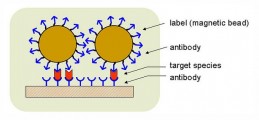Magnetic nanobeads miniaturize bio/chem detection
April 27, 2011
Researchers at Oregon State University have found a way to use ferromagnetic nanobeads to help detect chemical and biological agents with high sensitivity and selectivity.
When a chemical of interest is detected via “ferromagnetic resonance,” information is sent to a tiny computer and immediately displayed to the user. No special thin films or complex processing is required.
The system might be used to detect almost anything of interest in air or water, the researchers said. Where immediate, accurate and highly sensitive tests would be needed, such as toxic anthrax, ricin or smallpox agents used in bioterrorism, rapid detection would be possible.
Routine and improved monitoring of commercial water treatment and supplies could be pursued, along with other needs in environmental monitoring, cargo inspections, biomedical applications in research or medical care, pharmaceutical drug testing, and food safety.
When fully developed as a handheld, portable sensor, the technology will provide a complete diagnostic laboratory on a single chip, the researchers said.
Ref.: Esha Chatterjee, Tim Marr, Pallavi Dhagat, Vincent T. Remcho, A microfluidic sensor based on ferromagnetic resonance induced in magnetic bead labels, Sensors and Actuators B: Chemical, 2011; DOI: 10.1016/j.snb.2011.02.012


